Chiloé Island Tours and Things To Do
 by Kat Dougal on 20th June, 2024
by Kat Dougal on 20th June, 2024
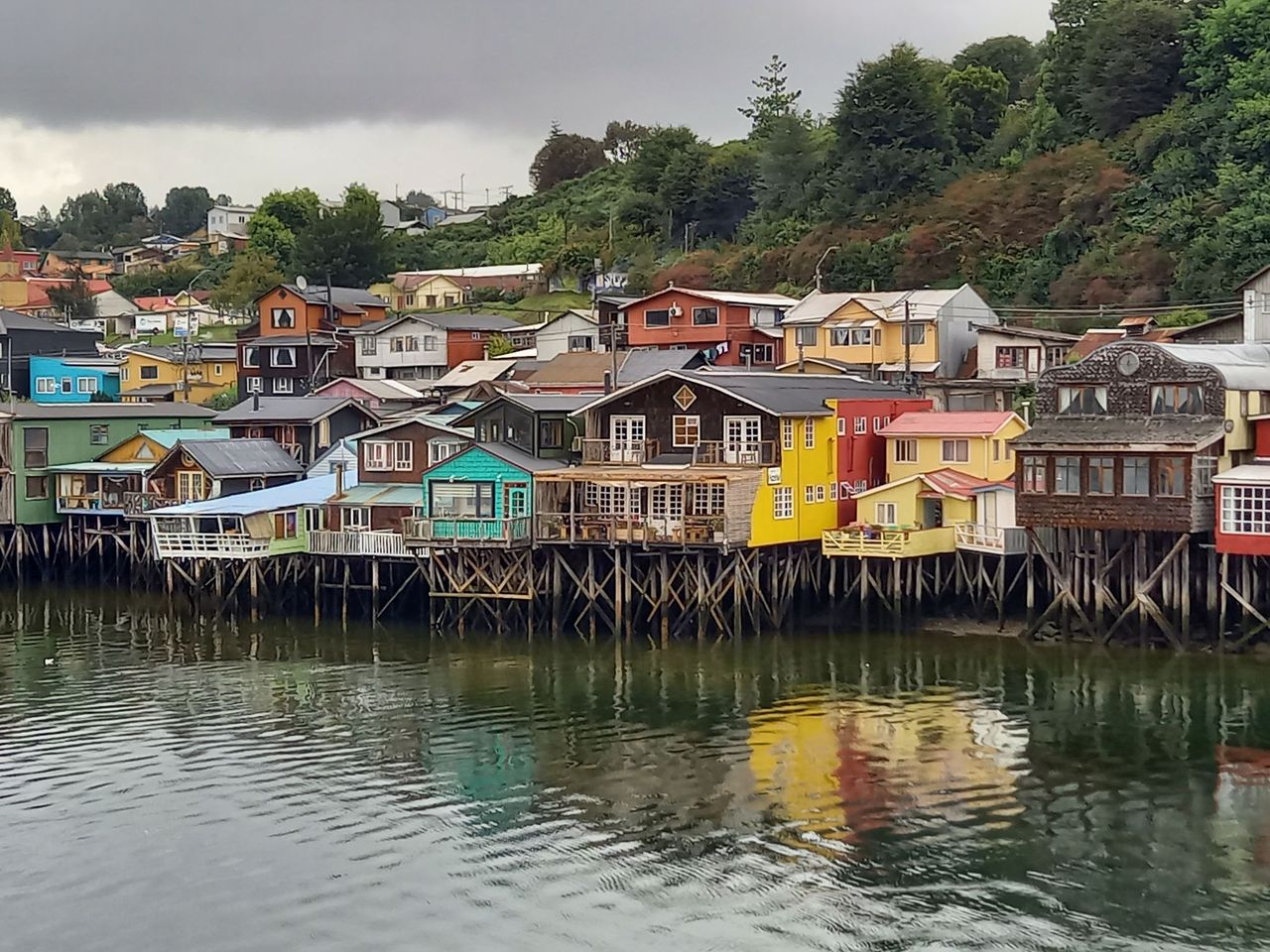
Chiloé Island Tours, Activities and things to Do
There is so much to do and see on Chiloé Island that the main issue may be how to fit all those tours and activities into your travel itinerary.
The island of Chiloé, in Chile’s Lake District, was once a strategic point of interest for seafarers and pirates alike. Fortunately, for the intrepid traveller, it now seems often overlooked by tourists visiting Chile.
Yet it really shouldn’t be, as here you will find a culturally rich land, with landscapes ranging from temperate rainforests to agricultural land of rolling hills to pristine sand beaches. Add penguins and ever-interesting weather, and you’ll want to make Chiloé Island your next holiday destination.
Read on for our top tips and idea on what to do on Chiloé Island.
How Many Days Should I Spend on Chiloé Island?
4 to 5 days.
We recommend spending three or four nights on Chiloé Island. It is also worthwhile exploring some of the small islands around Chiloé.
For example, the island of Quinchao is a five-minute ferry ride from Dalcahue, and here, you can visit the churches of Santa María de Loreto in Achao and Nuestra Señora de Gracia in Villa Quinchao.
Here’s our outline suggested itinerary for a self-drive tour around Chiloé Island.
Day 1 Fly to Puerto Montt or Mocopulli airport. Pick up a hire car, and drive to Castro and explore the town.
Day 2 Drive to Chiloé National Park for some self-guided walks and sightseeing.
Day 3 Drive to Dalcahue and visit the market before getting the ferry to Quinchao Island. Visit Unesco churches and charming towns
Day 4 Choose a wildlife trip, whale watching or visiting the penguin colonies.
Day 5 Drop off the hire car and travel onwards.

Seafood at Castro fish market
How Do I Get to Chiloé Island?
You can fly directly to the island’s small airport, Mocopulli Airport (MHC). Alternatively, take one of the regular flights from Santiago to the nearby Puerto Montt airport.
For those hiring a car, Chiloé is easily reached in about three hours from Puerto Montt or Puerto Varas. Two car ferries serve the island with frequent and regular schedules, so you won’t wait long to reach Chiloé.
No reservation is needed for the ferries. It’s first come, first served, and payment is made directly on the ferry. Payment is accepted by card and cash (Chilean Peso).
Alternatively, you can book a fully guided tour with a private transfer or public bus to the island. All daily excursions are included, and the tour is led by excellent local guides.
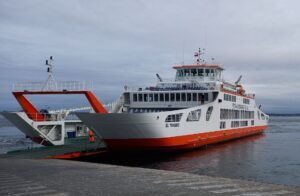
Ferry to Chiloé
Where Should I Stay on Chiloé Island?
Castro, the island’s capital, is also a base from which to explore the island. Here, you can choose to stay at a “palafito” hotel, a hotel on stilts, the town’s trademark architecture. There is a wide variety of accommodation options, and we can help you find the right hotel for you, of course.
The incredible Tierra Chiloé Hotel & Spa is located in a remote location on the eastern coast of Chiloé. It offers stunning views over the sea and wetlands. On a clear day, you can see the Andes in the background. In the right season, birdwatchers will delight in various species, including flamingos. There is a menu of activities, from cultural to active, with some fantastic boat trips aboard the hotel’s own boat, the Williche. Dolphins and sea lions are regularly seen here.
Horse rides are available for all guests, and in summer months, their full moon ride is not to be missed.
After your excursion, unwind in the hotel spa. Choose from a menu of treatments, or end your day in the heated infinity pool as you look out over the bay.
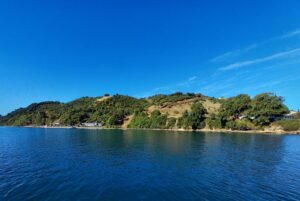
Tierra Chiloe Hotel and Spa
Chiloé’s Weather: When Should I Visit Chiloé Island?
Chiloé’s weather is notorious for its changes: expect multiple seasons a day! It’s generally considered a rainy place, hence the beautiful verdant Valdivian rainforest, so come prepared with suitable rain jackets and waterproof clothing,
A good time to go is between December and February. Not only is the weather statistically a bit drier, but it is also a great time for wildlife watching, with penguins hatching in January. Check the latest Chiloé forecast.
February is also a good choice for those interested in experiencing Chiloé’s culture, as many of the island’s festivals take place around this time of year.
Where Can I See Penguins on Chiloé Island?
Chiloé Island is unique in that Humboldt and Magellanic penguins nest here side by side at the Puñihuil Penguin Colony.

Magellanic Penguin
You can usually see the penguins between late October and March. They live on three islets some 15 miles / 27 km southwest of the Gulf of Ancud.
Chiloé Island Tours and Things To Do
Many people choose to visit Chiloé with their own car and find it easy to drive on the island. Chiloé’s network of roads connecting towns and sites is easy to follow, as the island is small. Driving is stress-free, and all the bigger towns have a petrol station.
However, there is also the option to explore the island on organised small group tours or with a private driver-guide. If you’d rather not hire a car, we can help you work out an itinerary that includes the highlights you’d like to see in the time you can dedicate to Chiloé.
Here are some of the unmissable travel highlights on Chiloé Island.
Chiloé National Park
Chiloé National Park lies on the west of the island and covers a large area of temperate Valdivian Rainforest, some stretches of dunes and a beach.
A network of trails takes you on forest walks of varying lengths in this fascinating ecosystem, great for birdwatching.
You can buy park entry tickets in advance (recommended) or pay on arrival. Adults pay CLP 7,500 (March 2024; please check online before you go.
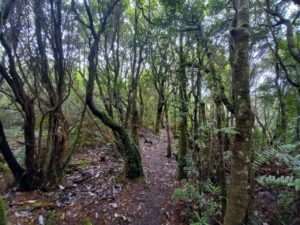
Chiloe National Park
Tepuheico Park
Tepuheico Park is an excellent alternative to Chiloé National Park, especially during the high season from December to February when the park is very busy with visitors.
It lies just a little South of Chiloé National Park. The forest walk experience is similar, but locals say you may have increased chances to spot local fauna, such as the Pudú.
The park is divided into two zones: bosque (forest) and costa (coast). Arriving from Castro, you reach the forest zone first (40 mins) but can then continue on towards Cucao to enter the coastal zone. The coastal zone has a wooden art installation called Muelle de los Tiempos. Stop here for a photo stop, of course.
Muelle de las Almas
This wooden art installation is a 17-metre pier leading into nowhere with a 70-metre drop at the end, a homage to the soul’s journey into the afterlife. It is one of the island’s most Instagramable spots, so be prepared for other tourists in high season.
You reach Muelle de las Almas (Dock of the Souls) after driving from Cucao (follow the signs) along a gravel/dirt road. A 4×4 will get you all the way to the access point; any other car will likely give up a little earlier.
It’s a 2.5km walk from the parking point to the Muelle de la Armas (5km round-trip).
Chiloé’s churches
Chiloé’s wooden churches, built to imitate the architecture of Europe’s majestic churches and cathedrals, have been awarded UNESCO World Heritage status. It may not sound like much, but on visiting, you will see what makes them so unique.
There are more than 70 churches on the island. Not all are open at all times, but you’ll be sure to find one open.
We recommend you visit the churches of Castro, Dalcahue, and Nercón, which are centrally located. A little further afield, the churches on Quinchao and Lemuy island are worth visiting.
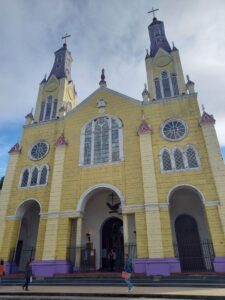
San Francisco Church, Castro
Quinchao Island
The small island of Quinchao, lying to the east of the main island, is accessible by ferry from Dalcahue (first come, first served and pay on arrival). Those with more time will enjoy exploring this small island and its green, rolling hills. To complete your visit, stop off at the aforementioned churches.
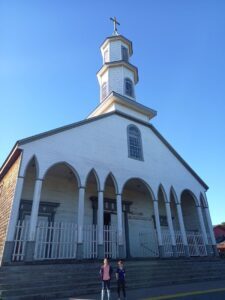
Dalcahue Church, Chiloe
Castro and Dalcahue
All visitors will likely visit Castro, the island’s capital town. Its main square is dominated by a church built with a mix of corrugated iron and wood. Its waterfront is lined by picturesque and colourful houses on stilts, called “palofitos” by the Chilotes, from ‘palo’, the Spanish word for stick. Make sure you stay at a palafito hotel or visit one of the palafito restaurants and cafes for beautiful views over the water.
Dalcahue lies about half an hour to the North of Castro. It is home to another beautiful church and has a strong focus on island handicrafts, mostly wood and wool products.
Stroll along Dalcauhue’s promenade along the water, and you will find many fishing boats anchored here. All brightly coloured, the boats make for a lovely sight and that perfect holiday photo.
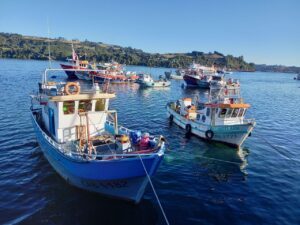
Fishing boats Chiloe
Punuihil Penguin Colony
Boat trips from Punuihil offer the chance to see Humboldt and Magellanic penguins between October and March. Nowhere else will you find both species nesting side by side. Whales can be seen occasionally, as well as sea lions, dolphins (Peale’s and Chilean) and various bird species, such as the red-legged cormorant.
Whale Watching at Quellon
Blue whales are regularly seen around the waters here in the Corcovado Gulf. From Quellon, you can board whale-watching boat trips, or maybe a kayak trip appeals?
What Is the Food like and what is the Regional Speciality Dish on Chiloé Island?
Chiloé has a reputation for its local dishes, and no trip to the island is complete without trying some delicious Chiloé fare. That said, much of the island’s cuisine is based on fish, seafood, and the humble potato.
Its most famous menu choice is curanto, a mix of meat, seafood, vegetables and potatoes. It is cooked in a hole dug into the earth, heated with hot rock and covered by the enormous Chilean rhubarb leaves that are found throughout the island. The dish is filling and best shared between two!
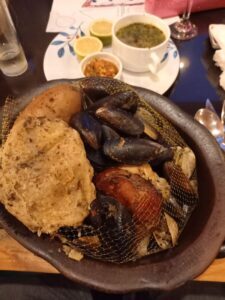
Curanto, a traditional dish
Is Chiloé Island Worth Visiting?
Chiloé Island mixes verdant scenery with ocean views and unique architecture to create an atmosphere like no other. The island’s wilderness feel is heightened by the wonderful wildlife, which gives visitors an explorer’s feel.
Its remoteness is its appeal, and we think Chiloé Island is well worth visiting for those who have time on their Chile holidays.
Get in touch!
The Andean Trails office loves Chiloé for its unique charm. We think it’s a great addition to any Chile holiday if you have time to stray from the all-time favourites of San Pedro de Atacama and Southern Patagonia.
The culture and landscapes and a sense of getting off the beaten track make this a fantastic destination for anybody interested in nature and wildlife.
Get in touch with us to plan your Chiloé holiday!
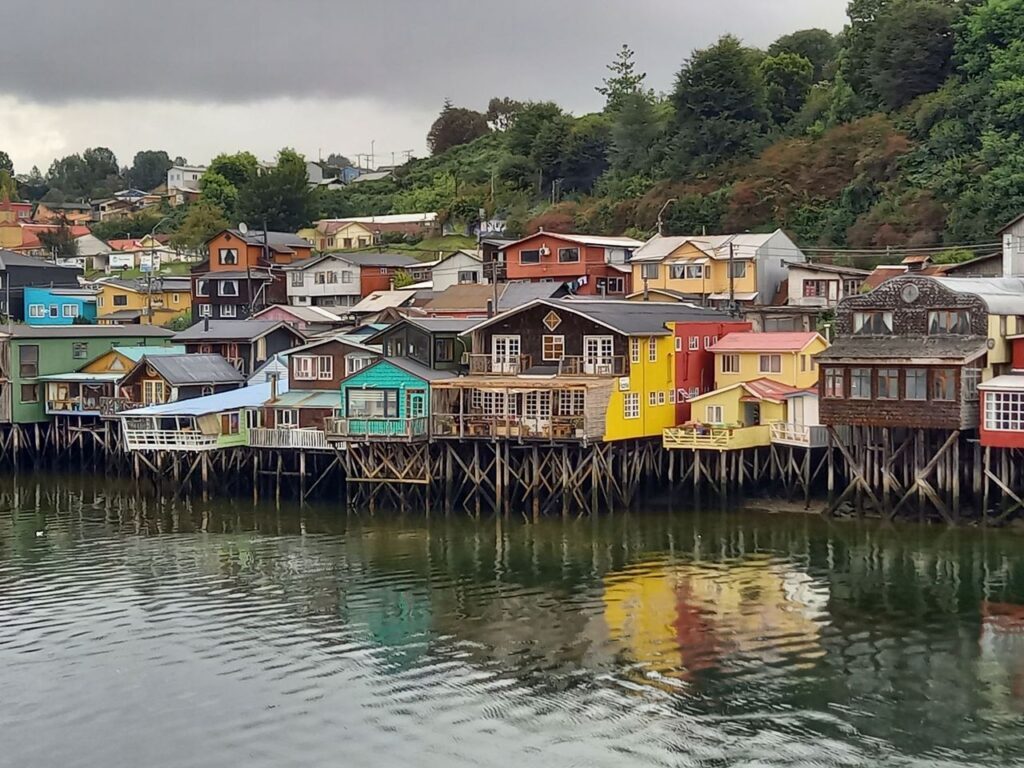
Share








